The RT-BE58U—a.k.a. RT-BE3600 for those who shop at Best Buy—is ASUS’s third dual-band Wi-Fi 7 standalone router, and the most modest out of the pack, compared to the previous RT-BE88U and RT-BE86U. However, it has enough for a home with Gigabit-class broadband.
Here’s the bottom line: The ASUS RT-BE57U is well worth its current price tag of less than $150. While the lack of a second 2.5Gbps port can be a downer, its generous feature set still makes it a formidable contender compared to similarly priced but less feature-rich Netgear Nighthawk S100.
Living in a relatively small home with modest broadband? Consider one today! Or you can get a couple to use as a system via AiMesh, preferably via wired backhauling.
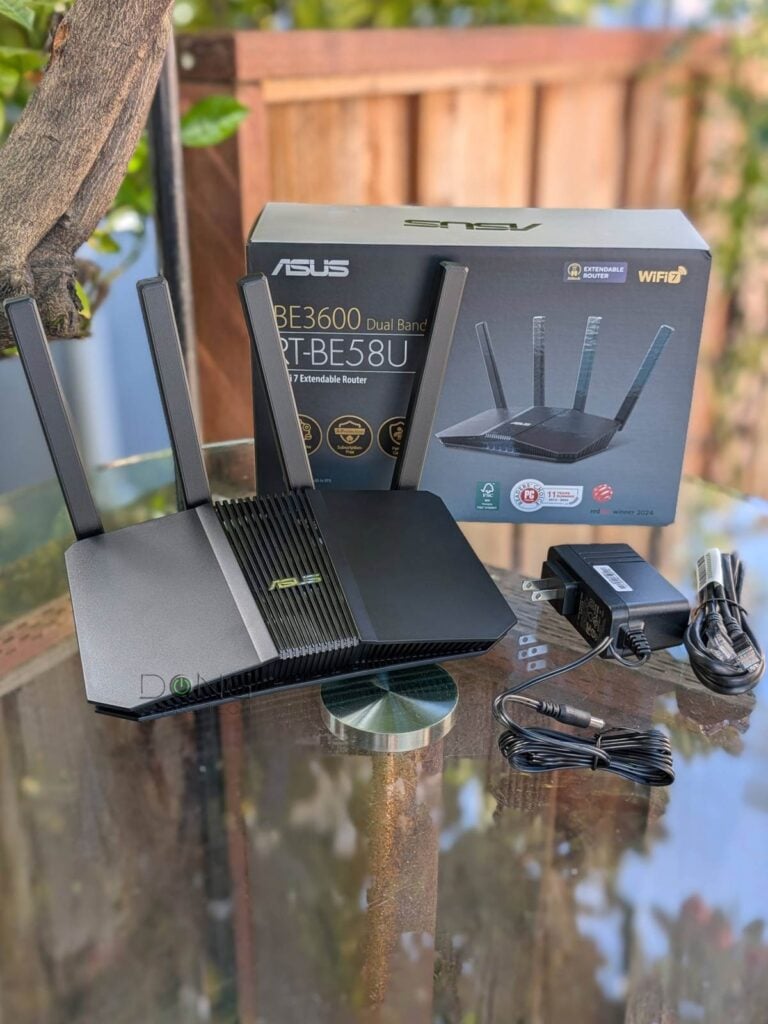
RT-BE58U: A bare-minimum Wi-Fi 7 router that can do a lot
The RT-BE58U is a compact router. Taking the traditional design of a typical router with four non-detachable antennas on the back, each can rotate half a sphere around. It looks like a sleeker version of the entry-level RT-AX58U Wi-Fi 6 older cousin.
Compared to the previous model, apart from Wi-Fi 7 support, the RT-BE58U has one more thing decisively better: a 2.5Gbps WAN port. Unfortunately, there’s no other Multi-Gig port. The router’s four LAN ports are all Gigabit.
Overall, the RT-BE58U has modest specs, which are just enough to qualify as a Wi-Fi 7 router. Compared with the Netgear Nighthawk S100, it shares the same hardware specs and is very similar to the TP-Link Archer BE230. The table below shows the specs of the three.
ASUS RT-BE58U vs. NETGEAR Nighthawk RS100 vs. TP-Link Archer BE230: Hardware specifications
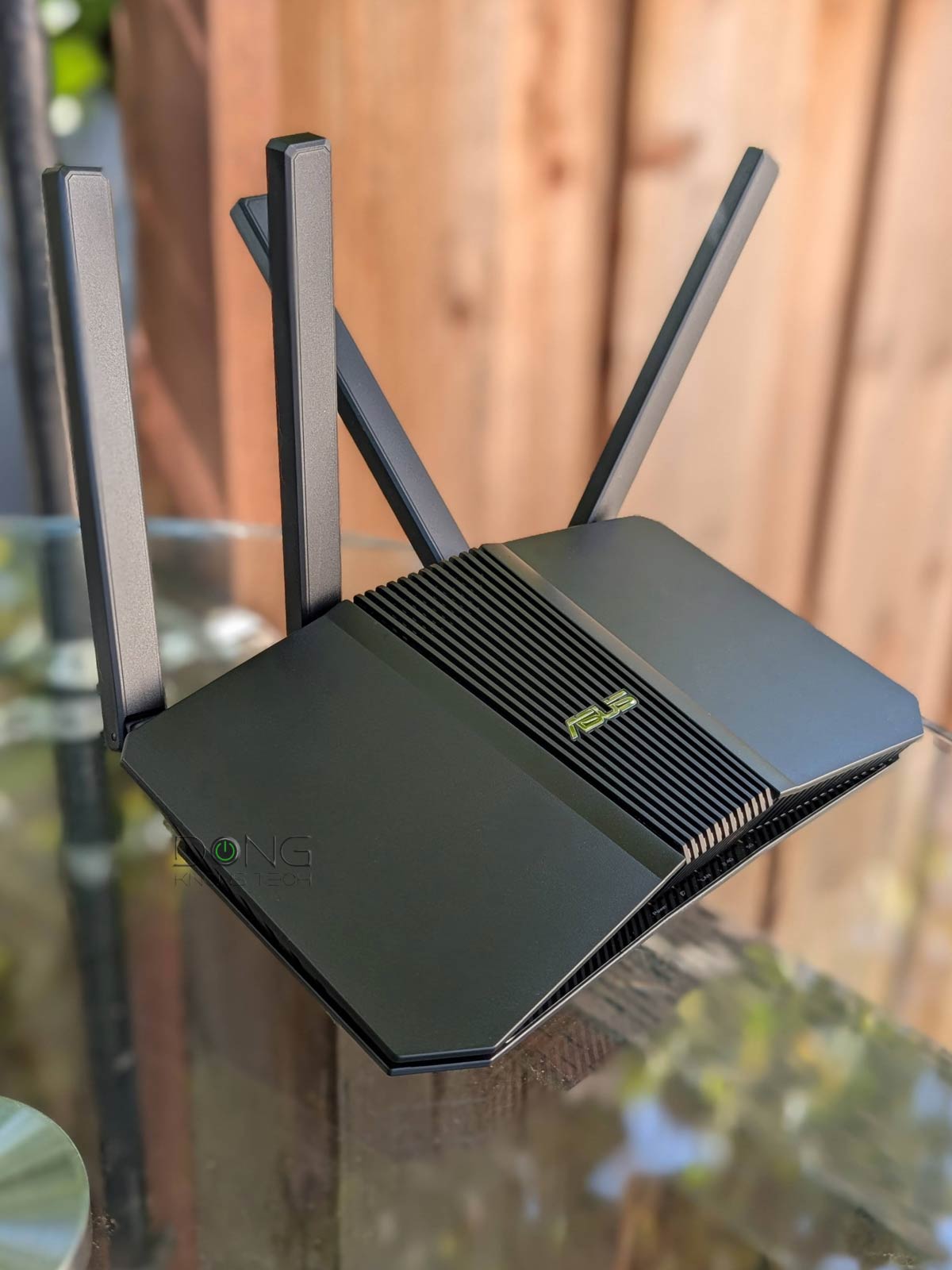 |  |  | |
|---|---|---|---|
| Name | ASUS RT-BE58U Dual-band Wi-Fi 7 Router | TP-Link Archer BE230 BE3600 Wi-Fi 7 Router | NETGEAR Nighthawk RS100 Wi-Fi 7 BE3600 Router |
| Model | RT-BE58U | Archer BE230 | RS100 |
| Wi-Fi Bandwidth | Dual-band BE3600 | ||
| 2.4GHz Band (channel width) | 2×2 BE: Up to 688 Mbps (20/40MHz) | ||
| 5GHz Band (channel width) | 2×2 BE: Up to 2882Mbps (20/40/80/160MHz) | ||
| 6GHz Band | None | ||
| Stream per Band | 2×2 | ||
| Network Standards | IEEE 802.11a, IEEE 802.11b, IEEE 802.11g, IEEE 802.11n, IEEE 802.11ac, IEEE 802.11ax, IEEE 802.11be, IPv4, IPv6 | ||
| Network Features | Web user interface ASUS Router mobile app Generous free features and settings (VPN, AiProtection, Parental Control, QoS, etc.) | Web user interface TP-Link Tether mobile app Standard free features and settings | Web user interface Nighthawk mobile app Limited free features and settings |
| Web-Based Remote Management | Yes (via Dynamic DNS) | No | |
| Vendor Login Account | Optional (for the ASUS router app) | Optional (for Tether mobile app and web user interface) | Optional (for the Nighthawk mobile app) |
| Premium Add-on | None (all features free for life) | HomeShield Pro | NETGEAR Armor or Armor Plus |
| Mesh-Ready | Yes (AiMesh) | Yes (EasyMesh) | No |
| Operating Mode | Router Access Point AiMesh node Repeater (extender) Media Bridge | Router Access Point EasyMesh node | Router Access Point |
| Multi-Gig Port | 1x 2.5Gbps WAN | 1x 2.5Gbps WAN, 1x 2.5Gbps LAN | 1x 2.5Gbps WAN |
| Gigabit Port | 4x LAN | 3x LAN | 4x LAN |
| Automated Frequency Coordination (AFC) | N/A | ||
| Multi-Link Operation (MLO) | Yes | No | |
| Link Aggregation | No | ||
| Dual-WAN | Yes | No | |
| USB Port | 1x USB 3.0 | None | |
| Dimensions | 9.37 x 7.6 x 2.32 in (23.8 x 19.3 x 5.9 cm) | 13.52 x 9.25 x 3.90 in (34.34 x 23.4 x 9.9 cm) | 7.2 x 4.8 x 2.6 in (18.28 x 12.2 x 6.6 cm) |
| Weight | 1.02 lbs (461g) | 1.32 lbs (.6 kg) | 0.4 lb (380 g) |
| Processing Power | 2.0GHz quad-core CPU, 512MB Flash, 1GB DDR4 RAM | undisclosed | 2.0GHz quad-core CPU, 512MB Flash, 1GB DDR4 RAM |
| Power Intake | 110-240V | ||
| Firmware (at review) | 3.0.0.6.102_37090 | 1.0.3 Build 20240612 rel.13057(5553) | V1.0.1.78 |
| Power Consumption (per 24 hours) | ≈ 200 Wh | ≈ 195 Wh | ≈ 105 Wh |
| US Release Date | Early 2025 | July 23, 2024 | February 2025 |
| US Launch Price (Compare current Prices!) | $149.99 | $99.99 | $149.99 |
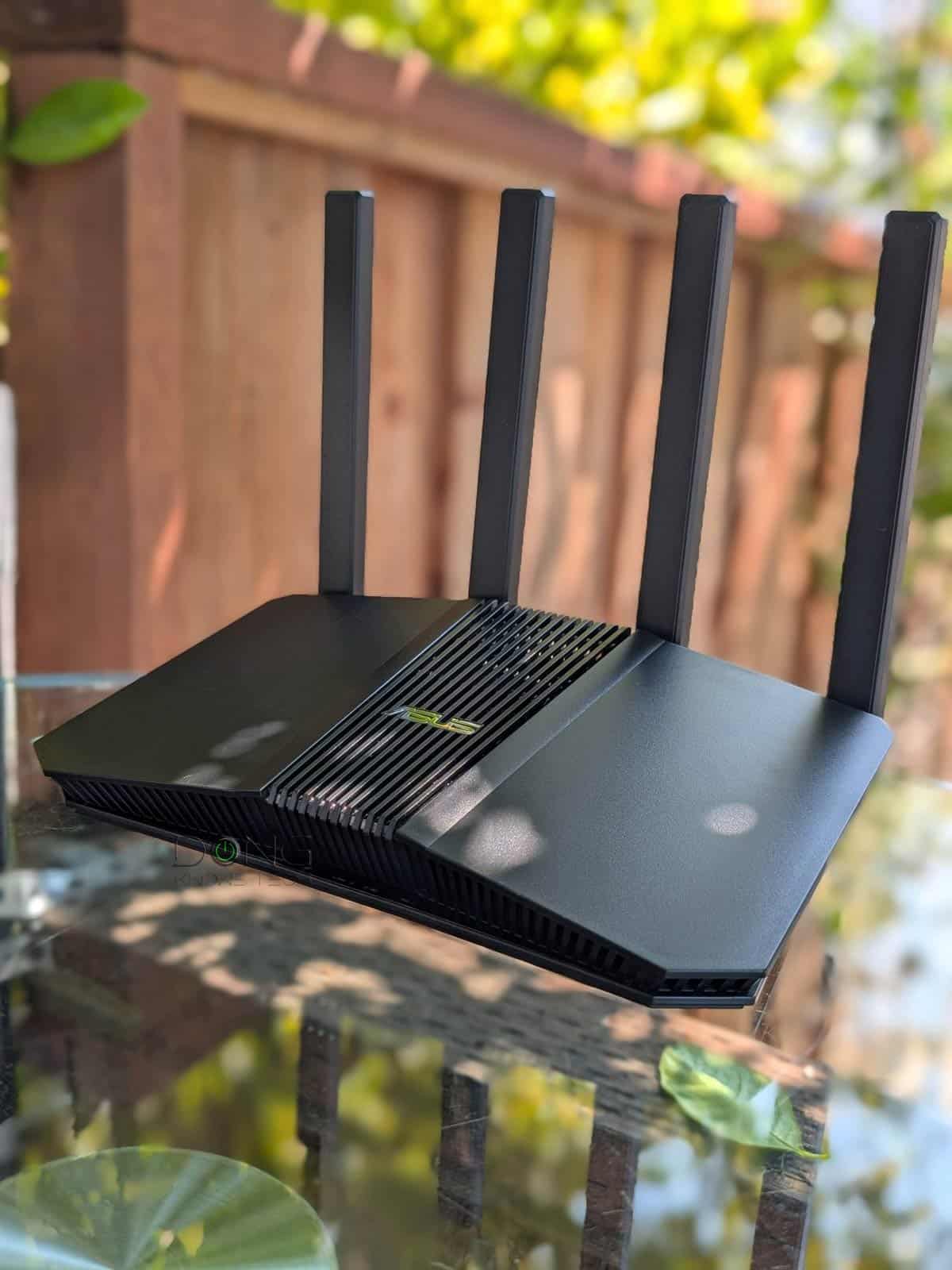
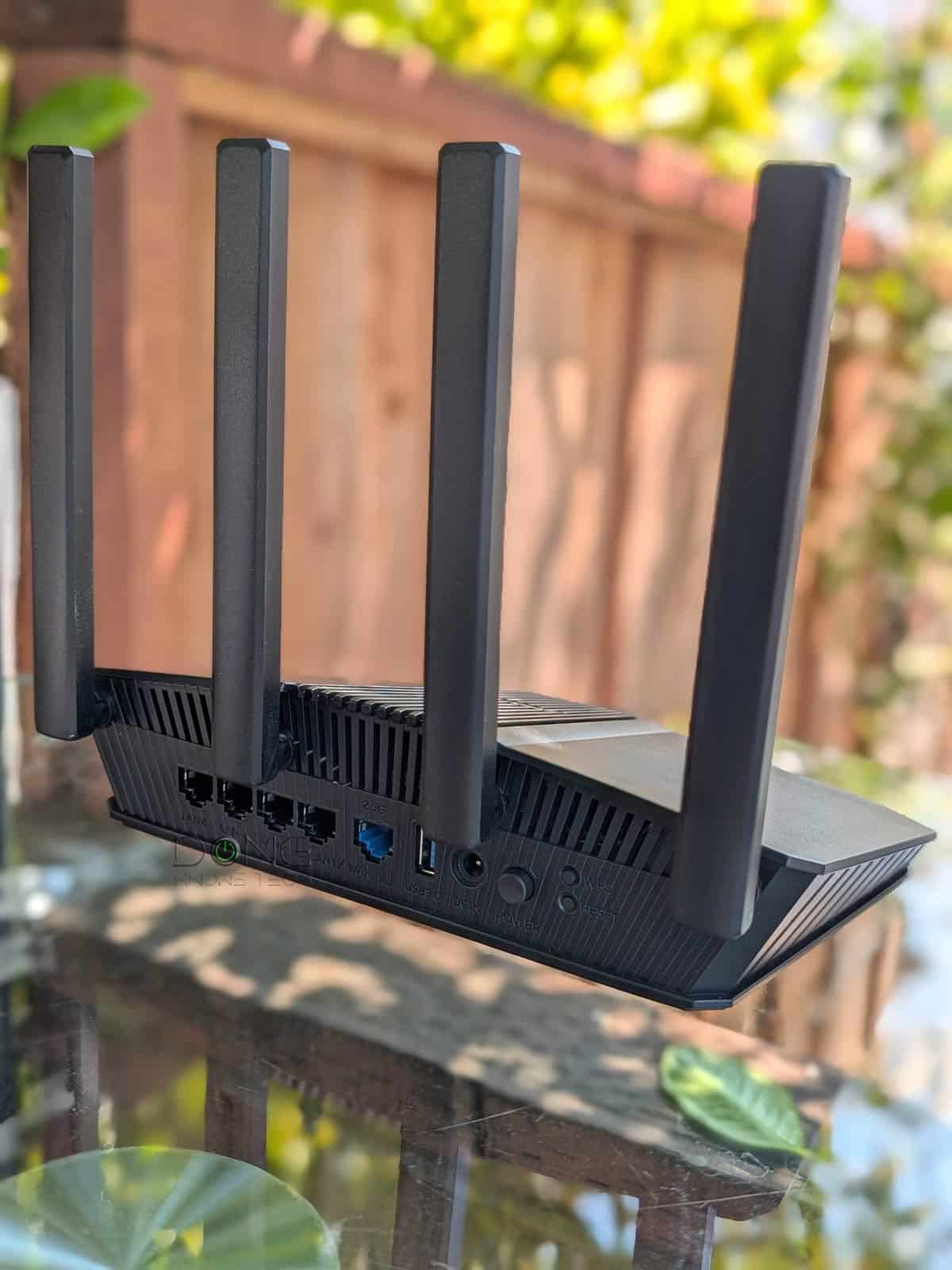
The single-2.5Gbps-port pain
As shown in the table, the RT-BE58U, as well as the Nighthawk S100, has only one 2.5Gbps. As a result, you won’t be able to get a real 2.5Gbps wired connection from it. And if you want to use two units to form a Wi-Fi system, there’s no way to have a multi-Gigabit wired backhaul while hosting a Gigabit or faster broadband connection.
Speaking of which, the RT-BE58U is better than the RT-AX58U because it can handle a Gigabit broadband without losing any bits due to overhead. After that, it’s very much a Gigabit router.
As a dual-band router, the RT-BE58U lacks support for the 6GHz band, which is not a big deal in regions where it is not available or only partially adopted. However, both of its bands have modest entry-level specs, resulting in less wireless bandwidth than many top-tier Wi-Fi 6 or even Wi-Fi 5 routers.
The adoption of the 6GHz band for Wi-Fi around the world
The 6GHz band has a total width of 1200 MHz, ranging from 5.925 MHz to 7.125 MHz, and is divided into 59 channels of 20 MHz each. These channels are grouped to create “sub-bands,” which also vary from one region to another.
In the U.S., the FCC has designated four sub-bands across the entire 6GHz spectrum, including UNII-5, UNII-6, UNII-7, and UNII-8, for Wi-Fi use, though portions of the band may be reserved for other applications.
The E.U. Commission allows only the UNII-5 equivalent part of the frequency for Wi-Fi use, which is 480 MHz in width from 5925 MHz to 6425 MHz. Some other parts of the world are somewhere in between, with the UNII-5 portion adopted and the rest being considered. In the rest, this band may not even be available for Wi-Fi at all.
Generally, Wi-Fi 6E needs a 160MHz channel to deliver the best performance, and Wi-Fi 7 requires double that, 320MHz. Due to spectrum availability and other reasons, real-world hardware tends to use narrower channels in most cases.
Overall, the use of the 6GHz frequency is complicated and is the main reason a Wi-Fi broadcaster made for one region might not work in another.
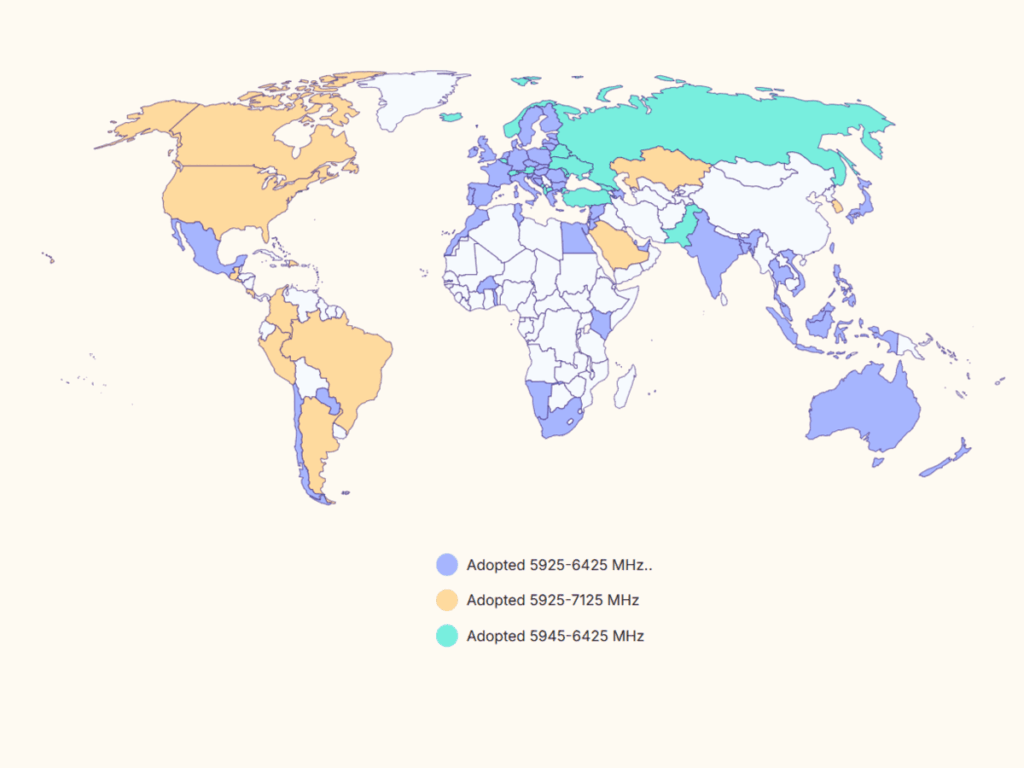
The table below shows its current adoption worldwide. The “Considering” portion is generally slated to be finalized eventually, though that varies from one region to another.
| Country | Adopted Spectrum |
|---|---|
| United States | 5925-7125 MHz (entire band including UNII5, UNII-6, UNII-7, and UNII-8) |
| Albania | 5945-6425 MHz (UNII-5) |
| Andorra | 5945-6425 MHz |
| Argentina | 5925-7125 MHz |
| Australia | 5925-6425 MHz |
| Austria | 5945-6425 MHz |
| Azerbaijan | 5925-6425 MHz |
| Bahrain | 5925-6425 MHz |
| Bangladesh | 5925-6425 MHz |
| Belarus | 5945-6425 MHz |
| 5945-6425 MHz | |
| Belgium | 5945-6425 MHz |
| Bosnia and Herzegovina | 5945-6425 MHz |
| Brazil | 5925-7125 MHz |
| Bulgaria | 5945-6425 MHz |
| Burkina Faso | 5945-6425 MHz |
| Canada | 5925-7125 MHz |
| Chile | 5925-6425 MHz |
| Colombia | 5925-7125 MHz |
| Costa Rica | 5925-7125 MHz |
| Croatia | 5945-6425 MHz |
| Cyprus | 5945-6425 MHz |
| Czech Republic | 5945-6425 MHz |
| Denmark | 5945-6425 MHz |
| Dominican Republic | 5925-7125 MHz |
| Egypt | 5925-6425 MHz |
| El Salvador | 5925-7125 MHz |
| Estonia | 5945-6425 MHz |
| European Union | 5945-6425 MHz |
| Faroe Islands | 5945-6425 MHz |
| Finland | 5945-6425 MHz |
| France | 5945-6425 MHz |
| Georgia | 5945-6425 MHz |
| Germany | 5945-6425 MHz |
| Gibraltar | 5945-6425 MHz |
| Greece | 5945-6425 MHz |
| Guatemala | 5925-7125 MHz |
| Honduras | 5925-7125 MHz |
| Hong Kong | 5925-6425 MHz |
| Hungary | 5925-6425 MHz |
| Iceland | 5945-6425 MHz |
| India | 5945-6425 MHz |
| Ireland | 5945-6425 MHz 6425-7125 MHz |
| Isle of Man | 5945-6425 MHz |
| Italy | 5945-6425 MHz |
| Japan | 5925-6425 MHz 6425-7125 MHz |
| Jordan | 5925-6425 MHz |
| Kazakhstan | 5925-7125 MHz |
| Kenya | 5925-6425 MHz |
| Latvia | 5925-6425 MHz |
| Liechtenstein | 5945-6425 MHz |
| Lithuania | 5945-6425 MHz |
| Luxembourg | 5945-6425 MHz |
| Macao | 5945-6425 MHz |
| Macedonia | 5945-6425 MHz |
| Malaysia | 5925-6425 MHz |
| Malta | 5925-6425 MHz |
| Mauritius | 5925-6425 MHz |
| Mexico | 5925-6425 MHz |
| Moldova | 5925-6425 MHz |
| Monaco | 5945-6425 MHz |
| Montenegro | 5945-6425 MHz |
| Morocco | 5925-6425 MHz |
| Namibia | 5925-6425 MHz |
| Netherlands | 5945-6425 MHz 6425-7125 MHz |
| New Zealand | 5925-6425 MHz |
| Norway | 5945-6425 MHz |
| Pakistan | 5945-6425 MHz |
| Paraguay | 5925-6425 MHz |
| Peru | 5925-7125 MHz |
| Philippines | 5925-7125 MHz |
| Poland | 5925-7125 MHz |
| Portugal | 5945-6425 MHz 6425-7125 MHz |
| Qatar | 5925-6425 MHz |
| Romania | 5925-6425 MHz |
| Russian Federation | 5925-6425 MHz |
| San Marino | 5925-6425 MHz |
| Saudi Arabia | 5925-7125 MHz |
| Singapore | 5925-6425 MHz |
| Slovakia | 5925-6425 MHz |
| Slovenia | 5925-6425 MHz |
| South Africa | 5925-6425 MHz |
| South Korea | 5925-7125 MHz |
| Spain | 5945-6425 MHz |
| Sweden | 5945-6425 MHz |
| Switzerland | 5945-6425 MHz |
| Thailand | 5925-6425 MHz |
| Togo | 5925-6425 MHz |
| Tunisia | 5925-6425 MHz |
| Turkey | 5925-6425 MHz |
| Ukraine | 5925-6425 MHz |
| United Arab Emirates | 5925-6425 MHz |
| United Kingdom | 5945-6425 MHz |
| Holy See (Vatican City State) | 5945-6425 MHz |
| Vietnam | 5945-6425 MHz |
The familiar feature set of ASUS’s RT series
Other than the hardware specs, like previous models, the new ASUS RT-BE58U is simply another variant within ASUS’s RT series that runs the latest ASUSWRT 5.0 firmware, though it has nuanced differences due to its modest specs.
Specifically, you can expect the following:
- The router features dual-WAN—you can turn one of its LAN ports or the USB port into the second WAN port. This USB port can host a cellular Internet source, such as a modem or a phone. However, there’s no Link Aggregation.
- Universal backup restoration: You can load the backup file of almost any other ASUS router onto the RT-BE58U. I tried it with a couple of dual-band models, and they worked as intended. This makes upgrading from one router to another a quick job.
- Robust web user interface with optional ASUS Router mobile app. You can set up the router the way you do any standard router via its default IP address, which is 192.168.50.1.
- AiMesh support. The RT-BE58U works best with wired backhauling. In this case, it’s an excellent satellite note for other dual-band Wi-Fi 7 routers from ASUS since you’ll get a 2.5Gbps wired backhaul link out of its WAN port.
- Built-in Parental Controls and online protection (AiProtection) plus other traffic-related features, including a robust QoS engine.
- USB-based features (cellular tethering, network storage, media streaming server, etc.)
- The new router supports advanced VPN, including WireGuard and Instant Guard.
- Tons of useful network/Wi-Fi settings, tools, and other features, including web-based remote management via Dynamic DNS.
The point is that if you’ve used a router with a standard local web user interface before, you’ll find the RT-BE58U a familiar experience. Like usual, the router is best set up and managed via its rich web user interface.


ASUS routers and your privacy
By default, all ASUS routers don’t require users to use a vendor-connected or third-party login account or provide personal information to the vendor to work.
However, when you turn on their specific features that require scanning the hardware’s traffic, such as gaming, traffic monitoring, AIProtection, parental control, etc., or manually bind the hardware to a login account for convenient remote management, that would translate into potential privacy risks.
Here’s the Taiwanese hardware vendor’s Privacy Policy.
Privacy and security are always nuanced, and data collection varies from one company to another.
Flexible Wi-Fi settings
The RT-BE58U features MLO—the 5GHz and 2.4GHz into a single link for supported clients—and has many options in terms of virtual SSIDs (called “Networks”) and the configuration of each. Specifically, you can create a primary SSID for each band, or combine them into a single (MLO) SSID. After that, you can make up to virtual SSIDs for different purposes, such as Guest Wi-Fi, IoT, or a separate MLO SSID.


It’s worth noting, though, that apart from the Guest Wi-Fi, which you want to have isolated from the main network, you should make the rest of the virtual SSIDs as part of the main subnet to have them work as intended.
Tip
ASUS’s self-defined networks (SDNs), a.k.a. virtual SSIDs, can be set to be part of the same subnet as the primary network, which might or might not be the default option when you first create them. If picked not to be part of the primary subnet, a virtual SSID will belong to a different subnet separated from the main network, which can cause local connection issues for those who are unaware.

Unless you’re fluent in handling multiple subnets, it’s best to use these SSIDs with the same subnet as the main network. To change the subnet, you might need to delete the SSID and recreate it.
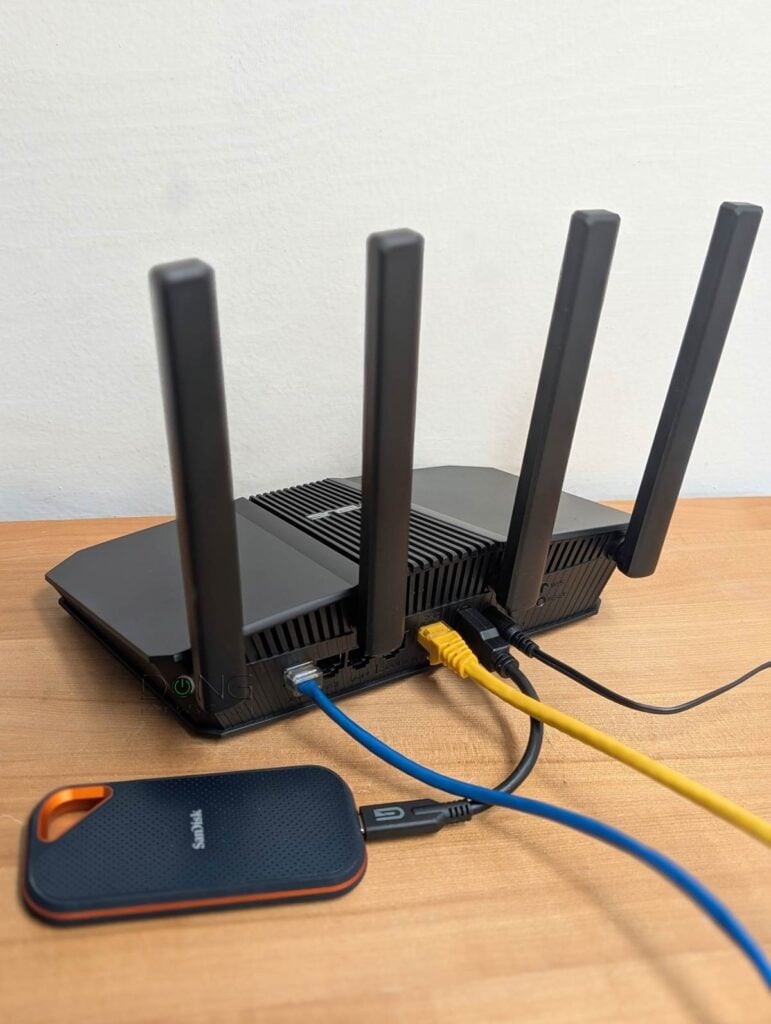
ASUS RT-B58U: Excellent performance for the specs, modest range
Considering the modest specs, I didn’t expect the RT-BE58U to wow anyone, and it performed as intended in my testing. Due to the lack of a 2.5Gbps LAN port, I tested its Wi-Fi performance via the WAN port to avoid performance limitations due to Gigabit speeds. Generally, the router’s 5GHz band can deliver Gig+ at a reasonable distance.


As shown on the charts above, the RT-BE58U generally outperformed the NETGEAR counterpart at close range. Farther out, it was less impressive.
Range is always tricky to figure out. If you live in a home of around 1500 ft2 (140 m2), you can generally expect this router to blanket it all when placed at the center. However, some claimed to have it handle a house of 2500 ft2 (232 m2). So your mileage will vary depending on the layout of your place. As mentioned, you can always get another unit to extend the coverage thanks to AiMesh.
The RT-BE58U did well as a mini NAS server when hosting a portable SSD via its USB 3.0 port. In fact, it proved to be the fastest one among Gigabit routers—there was no way to measure its performance other than via a Gigabit connection. (If you want to know how this router’s NAS rates compare against all other USB-enabled routers, including those with Multi-Gig LAN ports, check out this post.)


Other than that, the RT-BE58U passed my 3-day stress test without any disconnection and was completely silent during operation—it has no internal fan. The router also remained cool to the touch even during heavy operation, which is always a good thing.
ASUS RT-BE58U (RT-BE3600)'s Rating
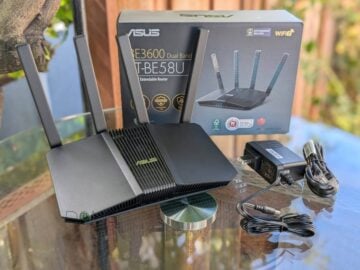
Pros
Wi-Fi 7 with MLO and 2.5Gbps WAN port
Reliable performance with Gigabit-class NAS performance when hosting a portable drive
Generous feature set that's free for life
Universal setting backup and restoration; compact and fanless design
Cons
No 2nd Multi-Gig port, modest specs
Not wall-mount-ready
Conclusion
Among the current entry-level dual-band Wi-Fi 7 routers, the ASUS RT-BE58U, as well as its RT-BE3600 variant, is the most feature-rich, compensating for its lack of a second 2.5Gbps port, making it a decidedly better investment than the Netgear Nighthawk S100. That said, get one (or two for a Wi-Fi system) today! If you want a better port with fewer features, the TP-Link Archer BE230 is also worth consideration among the three.



Hello,
I have a hard time to decide between ASUS RT-BE58U V2 and TP-Link Archer BE230 (a.k.a Archer BE3600).
I rather won’t be able to use 2,5GB LAN any time soon so it isn’t that important. I assume that ASUS has better software than TP-Link? I noticed that ASUS has 1GB RAM and TP-Link has 512MB – how relevant is that in routers?
Should I just flip a coin? What would you pick between those two?
I’d go with the ASUS, Peter.
Thanks for reply. After my post I read your reviews once again and decided to go with the ASUS.
👍
Is there a difference between the RT BE 58U and BE RT-3600?
I would say very little if at all, Tony. It’s similar to the case of the RT-AX58U and RT-AX3000.
Thanks for clearing it up. Amazon sells the BE 58U and Best Buy the RT BE 3600. Different boxes but specs the same. Was not sure if they were virtually the same or different.
According to the FCC, they are the same, at least in the device filing.
https://fcc.report/FCC-ID/MSQ-RTBE7900
RT-BE58U
TUF-BE3600
RT-BE3600
There may be distinctions in packaging, visual appearance, and firmware, but hardware-wise, all three of these models are the same.
I’m currently running AIMesh with an RT-AX56U main unit and 3 RT-AC68U nodes, all on a wired backhaul. We’re moving to a new house which is more spread out, and I’m considering an RT-BE58U as my new main unit, with the AX56U moving to node status in our high use area and keeping the AC68Us as nodes in areas which are almost exclusively guest network zones.
Any problems with my plan? I know you warn against mixing wifi5 with wifi7, but I’m unclear as to how that will negatively affect us. I very much appreciate all the knowledge I’ve gained here!
Considering you have wired backhauling, Waldemar, that *might* work. As for why the combo is not recommended, this post on mixing AiMesh hardware will explain that in details and help you understand what to expect.
Good luck!
Hi Robert and Dong!
Frist thanks for the valuable content and discussion! Are the WAN and LAN ports in RT-BE58U definable in settings? I too have 2 RT-BE58U’s and a 500/500 internet connection to build a home mesh network. The 2.5G WAN has no benefit to me as WAN port but if I can use them to connect 2 routers as wired backhauling, that would be interesting. Is it feasible? How to set one of the LAN ports as a WAN port to ONT, if not in bridge mode?
Best regards!
You can’t use its 2.5Gbps port as a LAN port, James, you can only turn another LAN port into a second WAN in a Dual-WAN setup.
Thanks!
Yep, that’s exactly the setup I have, but with an 8-port 2.5gbe switch in the middle so I can make use of the 2.5gbe port on my NAS.
On the RT-BE58U, you can set the 2.5gbe port to LAN only, then use LAN 1 as the WAN port, set to whatever type of incoming signal you have (mine is coming in direct from a Frontier fiber ONT box). Of the 4 gigabit ports, LAN2-4 cannot be set to WAN, only LAN1 and/or the 2.5gbe port can be used as WAN (for dual WAN setups).
I set my pair of BE58U’s to use wired backhaul only so I don’t have to potentially deal with them attempting a wireless backhaul. Been super stable so far, no issues.
Not sure why Dong said you can’t do that, as I have that exact setup running right now and has been solid for months.
My mistake. You actually can change the port role via the dual-WAN tab. I was actually a bit confused since I was testing another ASUS model.
I actually grabbed two of these routers a few months ago, been completely solid. My incoming internet is only 500/500, so I use one of the 1Gbe ports for WAN and the 2.5Gbe goes to a 2.5Gbe switch with my NAS and the second BE58U as a wired node on it as well, so any local traffic is using 2.5Gbe. Would be curious to see your results in this kind of setup. I guess I should pull out a USB SSD and test to see what kind of speeds I get from the USB port since my config could actually make use of it, although my NAS has primary storage on NVMe and is a much better solution. Still curious though!
As mentioned, I tested the router’s Wi-Fi using that 2.5Gbps port, Robert. As for the USB-based NAS, it’s not the primary function of the router and folks shouldn’t use the setup as such. It’d be irresponsible of me to create wrong expectations.
Yeah, I think Asus is still using SMBv1, so definitely not recommended. It’s just the testing side of me that is always curious about the max capabilities of things! I have a good NAS that serves my file needs well and I have no desire to actually use the USB port on these routers.
Nope, Asus has completely dropped SMBv1 since its Wi-Fi 5 routers. Else, I would have mentioned that in the performance section.
Oh, interesting! I didn’t realize they switched to Samba, good to know!
From what I could find, Asus was still using and older version of Samba that only worked with SMBv1, so I just made that assumption. Guess I need to ssh in and see which version they have in the current 3.0.0.6 firmware. Samba 4.22 is the latest and supports SMBv3, but I highly doubt Asus is using that recent of a version.
Ok, just SSH’d in and checked. Samba 3.6.25 is the version in the latest 3.0.0.6.102_37090 firmware. Looks like it’s from February 2015, and yes, only supports SMBv1. So while Asus isn’t technically using SMB, the version of Samba they are using still only supports SMBv1.
Supposedly Merlin firmware supports SMBv2, but no Merlin for this router yet. 😥
I tested it via SMBv2, Robert. I know it *supports* SMBv1, most devices do, it’s the question if it *needs* SMBv1 to work, which it doesn’t.
As mentioned in the previous link, my test equipment has SMBv1 disabled.
Good to know, thanks! I know Samba 3.6 added basic support for SMBv2, but wasn’t enabled by default and previously, you had to manually edit the config to enable. I guess Asus went ahead and enabled with these by default, so that’s good news!